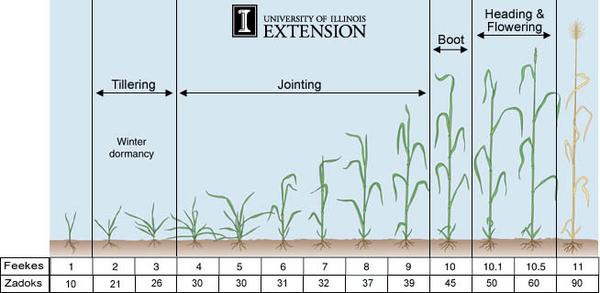Once this rain gets out of here and we can stand up in wheat fields we need to be considering our weed control options and applying early season fertility.
Fall tiller production is necessary for optimum yields to be accomplished. 15 to 30 pounds of preplant or at planting nitrogen (N) is usually sufficient to promote early tillering. If wheat is planted behind peanuts or soybeans the amount of residual N should be sufficient, but if you are following corn or cotton additional N may be needed. Either way now is a good time to consider an application of N to promote additional tiller production. The goal for fall and early winter N applications is to achieve 100+ tillers per square foot by the end of January or the first of February. Taking tiller counts and tissue testing at this time can help growers determine how much additional nitrogen needs to be applied by growth stage 30.

Growth stage 30 (Fekes 4) is the stage when the growing point has moved 1/2 inch up the stem. Prior to this the growing point is at the base of the stem. This can be determined by pulling plants and spitting the stem down the center to the roots. At this time in the growing season the spikelets per spike and spikes per plant are developing, and the grains per spikelet are being determined. These are some of the reasons that we want to make sure the plants have enough in the tissue and apply additional as needed to reduce stress. Obviously stress at this stage of growth can have a negative impact on yield.
Another factor that can add stress and reduce yields is weed competition and/or improperly timed herbicides. Historically growers in our area have waited until their final fertilizer application is February to also apply herbicides. This usually coincides with the transition from tillering to stem elongation (growth stage 30). A better management strategy is to apply weed control products prior to the end of December. Early herbicide applications are beneficial for two reasons. First, early application of herbicides can safely control most of our troublesome weeds and reduce competition promoting better tiller production. Second, growers can avoid applications during critical growth stages, such as growth stage 30.
Check back next week for the 2024 wheat weed control recommendations or contact your County Agent for assistance.